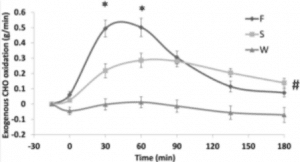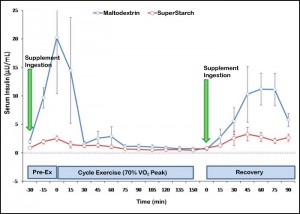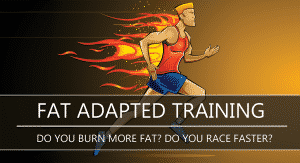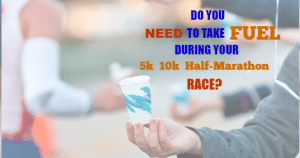If you’ve been running half marathons or marathons for any length of time, then you’ve likely heard of UCAN.
Their line of LIVESTEADY energy gels and powders are marketed to be different from your traditional gels and carbohydrate drinks because they provide a slow release of energy, rather than all at once after being absorbed into the bloodstream.
This theoretically reduces the spike, and subsequent crash, of blood sugar levels, which provides a more stable and consistent energy level throughout the race.
But, do these claims actually hold up?
In this article, we’re going to examine everything in-depth; from exactly what LIVESTEADY is, how it works, why having stable blood sugar matters, and whether there is actually any scientific evidence to back this all up.
We’ll take a look at a few scientific studies that examined precisely that question.
What is LIVESTEADY?
Generation UCAN’s “LIVESTEADY” is a commercialized version of a processed form of corn starch that was originally developed to treat a rare genetic disorder called glycogen storage disease type.
People who have this condition can store glycogen in their liver, but can’t release it as free glucose in their bloodstream. As a result, they have chronically low blood sugar. One avenue for treatment is frequent intake of corn starch, which provides a steady influx of glucose into the bloodstream.
As you might imagine, snacking on corn starch every few hours isn’t the most appealing medical treatment, which led researchers to seek out carbohydrate preparations that could provide glucose at a slower, steadier rate. These research efforts led to “waxy maize heat modified starch”—the research-grade form of LIVESTEADY (1).
By using LIVESTEADY in a sports drink and energy gels, UCAN aims to apply the same advantages of this corn starch derivative to sports performance.
The hope is that you’ll get a steadier supply of carbohydrates, instead of the sharp spike in blood sugar that you get from a traditional sports drink.
Why stable blood sugar matters
There are quite a few reasons runners should be concerned about stabilizing blood sugar, both from a performance standpoint as well as overall health.
In terms of pure performance, spikes in blood sugar almost always result in a corresponding crash.
The “fix” for this is to continually supply the body with glycogen during training and racing so that you don’t ever get to the “crash” moment.
However, this lends itself to a couple of problems in itself, mainly that (1) you need to consume a lot of simple sugars to achieve this and (2) it’s easy to overdo it since you can only process so much simple sugar at once.
I’ve talked before about how your body can only digest and process around 350 calories per hour when running.
Even worse, this number dwindles the harder your run and the more tired you get. So, in the latter stages of a race this number might be only 250 calories per hour.
This happens because blood is needed to digest food in the stomach.
As you run faster and longer, the muscles you use for running require more and more blood to maintain pace. Therefore, your body shunts blood away from the stomach and to the working muscles. Without blood, the stomach cannot digest efficiently.
That means even if you ingested 500 calories every hour, you might only be able to use 250 to 350 of the calories.
Not only will the glycogen not be absorbed or used efficiently, but the calories that are not used could backup in your stomach could cause GI distress.
This is one of the biggest mistakes runners make when trying to avoid bonking. They take too many gels or other carb sources and they aren’t absorbed or result in GI distress.
Thus, keeping blood sugar levels more stable throughout training and racing will prevent the corresponding crash in blood sugar levels and thus the potential for over fueling to prevent it.
Evaluating the Research on UCAN
So, now that we understand the what and why, it’s time to examine if any of this is supported by scientific research.
The first scientific study on the carbohydrate formulation used in UCAN was published in 2011 in the journal Nutrition.
This study had ten trained cyclists perform 2.5 hours of cycling with an all-out sprint at the end. All of the subjects in the study completed the experiment twice: once using UCAN, and once using the traditional sports drink.
As expected, UCAN led to a blunted increase in blood glucose and an increase in fat oxidation. This means the athletes relied more on fat, and less on carbohydrates.

Blood glucose in runners
A follow-up study presented at the 2019 American College of Sports Medicine Annual Meeting used a similar approach, this time comparing UCAN to maltodextrin in runners completing a three-hour run.
In this study, ten experienced runners performed a series of time trials each 7 days apart. During each time trial, they consumed one of 3 different beverages containing 50g of either LIVESTEADY, a normal carbohydrate beverage, or plain water.
The results showed that blood glucose levels rose more slowly and hit a lower peak when the runners took UCAN compared to when they took a maltodextrin-based sports drink.

Is slow release always better?
Some researchers have raised questions about whether the primary strength of UCAN—its slow rate of energy release—could also be a weakness.
One of the reasons that traditional sports drinks like Gatorade use a combination of fructose and glucose is that these sugars release energy very quickly.
Anecdotal evidence suggests that the rate at which UCAN releases energy is sufficient in most cases, and for most athletes.
Some elite athletes, whose energy demands are very high, opt to use UCAN in conjunction with high glycemic carbohydrates, particularly late in sustained, high-intensity sessions/races.
In another study, this one from 2016, had cyclists perform a three-hour exercise protocol, comparing UCAN to a traditional sports drink.
In keeping with the research reviewed earlier, This study found that UCAN increased fat oxidation and decreased blood glucose levels.

A final study published in 2019 demonstrated that UCAN prevented a decline in soccer-related skills in the second half of a simulated soccer game, but the applicability of this study to running is questionable—you’re not likely going to be dribbling a soccer ball at the end of a marathon (6).
The bottom line on Generation UCAN
Based on the research done so far, a few things are clear…
- UCAN’s SuperStarch is absorbed quickly through the stomach into the intestine, and then slowly releases energy into the body.
- Your blood glucose levels will rise more slowly when you drink UCAN compared to if you’d taken a traditional sports drink.
- Your fat oxidation will increase compared to using traditional drinks and gels.
- The physiological changes associated with UCAN suggest that it should help even more during ultra events than it does in the marathon since ultra events rely primarily on fat oxidation.
The bottom line is that while UCAN isn’t a miracle worker (i.e. you’re not automatically going to perform better when you use it).
That said, it has been proven to improve fat oxidation, meaning you burn a greater percentage of fat versus carbohydrates at race pace and it has been shown to reduce GI distress. Moreover, using UCAN limits the amount of simple sugar you ingest.
If you’re someone who has hit the wall or constantly, has GI distress when using typical fueling method, or struggles with staying properly fueled during races, UCAN is perhaps the best scientifically-proven product on the market to help.
How to implement in your fueling plan
First, you want to make sure UCAN sits well in your stomach (as you should with any product you try).
So, if you are training for the marathon, you can try swapping out your usual sports drink or energy gel for UCAN on a day when you’re doing a long, strong run and see how your body reacts.
If you want to give it a try, head torunnersconnect.net/UCAN to get 6 Edge energy gels for free. You’ll just pay shipping.
Second, you’ll want to modify your fueling plan to account for needing less calories from carbohydrates.
Given the percentage change in carbohydrate and fat oxidation when using UCAN, you can expect to need about 30% less calories from carbohydrate during the race.
If you’re not exactly sure how many calories from carbohydrate you need already, you can nab our Marathon Nutrition Blueprint here. It comes with our revolutionary glycogen calculator that tells you exactly how much glycogen you to avoid hitting the wall.
Even better, if you use UCAN, we have a separate calculator to make the adjustment easy. All you’ll need is your weight, gender and goal time and you’ll have an exact fueling plan for the race based on whatever product you want to use.
If you’re not interested in the Nutrition Blueprint, you can watch this video to see how to calculate your own glycogen use.
Let us know if you have any questions!








